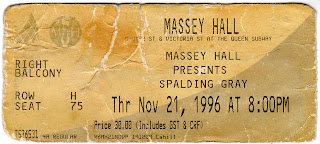I have this ticket stub (above) from a one-man-show – Spalding Gray at Massey Hall. It was good. I don’t know how to describe his “show” in practical terms: he didn’t sing, he didn’t dance, he didn’t perform in the traditional sense. He talked. About himself. He was a monologuist. And his stories would encapsulate, in ever widening circles of narrative, the great many wonderful and (more often) terrifying things going on with his life.
He was an actor/playwright whose home was primarily New York. I’m not sure if New York makes people like Gray anymore. These performances were not “actor/playwright” shows – these shows were, in retrospect, a form of therapy. Gray talked about the things – worries, revelations, lost epiphanies – which affected him as a regular human being; the things which happen around the things we do with our lives.
His best-known performance, captured on film by Jonathan Demme, is Swimming To Cambodia. In it, with a desk, chair, and glass of water he discusses the events which surrounded the time he played a small role in the critically-acclaimed film, The Killing Fields. He talks of his research for the role in the film, of what actually happened during the reign of terror in Cambodia during the early-to-mid 70s.
Gray was a man given to self-exploration, perhaps painfully so. His mother committed suicide while he was in his 20s, and he exhibited symptoms of bipolar depression himself. Her death held an eerie fascination for him. In subsequent performances (also made into films), Monster in a Box (about writing a novel) and Gray’s Anatomy (about his fear that he was going blind), he explored his neuroses and anxieties and how they filtered through his relationships with those close to him.
The key to Gray is that he was funny as hell, which turned all of his painfully honest accounts, his public descriptions of private contortions all the more enlightening for the viewer, as opposed to merely sympathetic. Gray was neurotic, but he wasn’t looking for sympathy from the audience, and I think this is the second key to understanding him (as a performer, at least). When I saw him at Massey Hall in November of 1996, I don’t remember a lot of details (it was his It’s a Slippery Slope tour), with the exception of his description of sitting outside, trying to have a soulful discussion with his distant father while a fog horn sounds in the distance. I remember this because I was laugh-crying throughout most of it.
When I heard in 2004 that Spalding Gray was missing, that it was suspected he had jumped off a ferry into the East River, I was not shocked. Suicide – as an objective event, as a subjective idea – was something he had discussed since Swimming to Cambodia. Add to this that he had been in a terrible car accident a few years earlier which had left his right leg partially disabled (not to mention having a fractured skull), and you could see (in retrospect, of course) how, given his frame of mind, it might have pushed those dark thoughts further toward the limelight of contemplation.
It is a shame.


